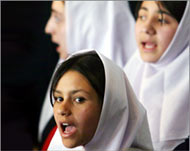UN: Afghan schools need more funds
Despite promises of help from Western governments for Afghanistan to help get its girls back to school, the country is not getting nearly enough money, even for basic facilities and staff.

UN Special Representative Jean Arnault said on Sunday that the number of children going to school was surging but more funds were needed to maintain the momentum, and 1.5 million girls of primary school age were still not being given a chance to study.
“A huge funding gap of some $173 million exists for this year alone,” he said at a ceremony in Kabul, the day before the start of the new school year.
Arnault called on countries taking part in a major Afghanistan aid conference in Berlin at the end of this month to reaffirm their commitment to education.
“The list of requirements is long, but the main ones are basic and familiar: new school buildings, improved teaching materials, new curriculums and more teachers – especially women.”
Arnault said the number of girls at school had risen steadily since the Taliban government, which banned all female education, was overthrown by US-led forces in late 2001.
Room for improvement
He said 30% more girls were now studying compared with 2002 and the emphasis on women’s education in a new constitution approved earlier this year should provide added impetus to this trend. But he said there was still a lot of room for progress.
|
“A telling statistic is that 1.5 million girls of primary school age are still not in school” Jean Arnault, |
“There are still many areas where girls’ enrolment is low and more effort must be made to reach out to those communities where education for girls is still not a reality,” he said.
“A telling statistic is that 1.5 million girls of primary school age are still not in school.”
The UN Children’s Fund (UNICEF) said in a statement it would launch a programme this year to develop 10,000 community-based schools to make it easier for 500,000 of the girls now out of school to get an education.
It said 5.5 million children out of an estimated eight million in the seven to 18 age-group were expected to attend school this year, compared to more than four million – 1.2 million of them girls – last year.
UN goals
UNICEF and the ministry of education aim to get one million more girls into school by 2005.
UNICEF said the community schools would be established in existing public buildings, mosques, private homes, or even in tents if no buildings were available.
 |
|
The UN wants donors to cover the |
Lack of facilities and of women teachers were limiting opportunities of girls, it said.
At the ceremony, also attended by President Hamid Karzai, US ambassador Zalmay Khalilzad announced that the United States would build 152 new schools and refurbish 255 in 2004.
He said since 2002, it had built and rehabilitated more than 200 schools, trained 2,100 teachers and distributed 10.3 million text books.
Karzai welcomed the initiatives, but added that building new schools was not enough.
“School is not just buildings, chalk and blackboards; we need good and expert teachers,” he said. “And my advice for all parents is that they should send their sons and daughters to school.”